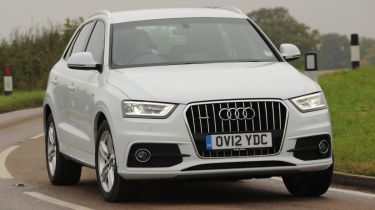Audi Q3 2.0 TDI quattro
Classy small SUV follows successful pattern set by its larger siblings
Audi's baby off-roader is unlikely to get muddy, but it offers the raised seating position, image and looks of a large SUV in a smaller, more efficient package. The boot is 40 litres bigger than the X1’s and the cabin serves up more space, too. Optional extras are very costly and in S line trim it’s a little expensive, but strong predicted residual values are a big plus point for private buyers.
The Q3 model line-up is only a year old, but Audi’s relentless range expansion means the compact crossover is no longer the newest metal in the showroom.
Nevertheless, a close resemblance to the handsome Q5, a classy image and compact dimensions ensure it still strikes the right note. The prominent grille, rounded roofline and the trademark clamshell tailgate are all familiar Audi SUV styling cues. In order to create a rugged 4x4 look, the standard Q3 gets wheelarches and side sills that contrast with the rest of the body colour, but S line models like the one we tested here get the full body-colour treatment and a smattering of subtle, sporty details.
Climb aboard and you’ll notice the taller ride height gives the Q3 a loftier driving position than the X1. But it’s the design of the cabin that really sets the Audi apart from the BMW. The instruments and general layout are crystal-clear and modern, while the materials are a step above the X1’s.
Used - available now
A beautifully damped 3.5-inch screen pops up manually from the dash and Audi’s MMI control system is a breeze to use, plus the optional sat-nav is excellent. But while leather is standard in the xLine-spec BMW, it’s a costly £795 optional extra in the Q3.
The most impressive option is the £220 Audi Drive Select system, which allows you to choose from Dynamic, Auto, Efficiency and Comfort modes at the touch of a button. Dynamic makes the steering heavier and sharpens throttle response, while at the other end of the scale, Efficiency mode optmises the car’s fuel economy.
In Comfort, the steering is noticeably lighter than the X1’s, making the car easy to live with at low speeds, but the weightier response in Dynamic doesn’t offer any better feedback – here the BMW still has the edge.
The two SUVs offer similar grip, but the taller-riding Q3 doesn’t control body roll as well as the X1 – although the trade-off is a more comfortable ride in the Audi.
The Q3’s 138bhp 2.0-litre engine is a bit noisier under load than the BMW’s, and it doesn’t feel quite as punchy. Still, at the track our two contenders were closely matched on performance, and quattro all-wheel drive ensures the Audi has easily enough traction. The six-speed manual transmission also has a precise shift action, and overall the car strikes a fine balance between handling and comfort.
Add in a bigger boot and slightly more rear legroom than in the X1, and you’ll find that the Audi is the more practical of the two as well.
In S line trim, it costs £1,110 more than the xDrive X1; opt for SE trim on both and the Audi is only £360 more expensive. Either way, its has slightly higher CO2 emissions, but much stronger residual values.
It isn’t revolutionary, but a tried-and-tested formula makes the Q3 a formidable choice.











